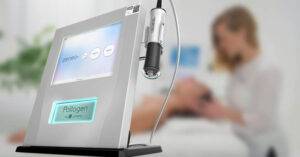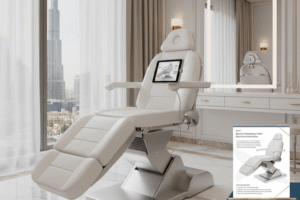
Best Oxygeneo Machine in the UAE: GeneO+ 3 in 1 Facial Device
In today’s competitive aesthetic market, dermatology clinics and skincare centers across the UAE need more than just skilled professionals; they
More Posts

In today’s competitive aesthetic market, dermatology clinics and skincare centers across the UAE need more than just skilled professionals; they

In a busy dermatology clinic, the right chair can make all the difference in efficiency, comfort, and treatment outcomes. Yet
Send Us A Message
Cleaning dental handpieces is one of the most critical things when it comes to dental clinics because the dentists expose themselves and the patients to an unlimited number of infectious diseases, and that is because of the direct contact with the patient’s blood and saliva.
Hence, cleaning and sterilizing dental tools takes an important part of the dental treatment to keep patients safe and away from hazardous illnesses that can affect their lives or lead to death in some cases.
In this article, we discuss why dental handpieces should be cleaned, what dentists should do before cleaning, the dental handpiece cleaning and sterilizing process, and storing the handpiece.
Dental tools in general, and specifically handpieces, should be cleaned because they are in direct contact with the patient’s blood and saliva, and that leads to infections and cross-infection diseases.
Dental tools, and especially high-speed dental handpieces, are in direct friction with the patient’s blood because dental handpieces suck blood, and it leaks to their interior part, and in this case, normal cleaning will not kill the sperm and microorganisms that are stuck inside them or on their surface.
In addition to this, some germs need high temperatures above 121°C, like in the case of autoclaving, to get rid of them, or they require a specific kind of chemical, such as ammonium chloride, to destroy their structure.
Getting in touch with secretions of an infected person leads to getting infected with the same disease, and we are talking about serious diseases that are incurable or take a long time and sanity to cure the body from.
Some diseases that transfer by blood are malaria, syphilis, and the human immunodeficiency virus (HIV), which are deadly diseases and hard to get cures for.
For this reason it is important to sterilize dental tools to prevent cross-infection diseases.
Dubai Health Authority set a bunch of rules that protect both patients and medical teams from different kinds of diseases by complying with those standards and being careful when using sensitive tools like the dental tools and especially the ones that are in direct contact with blood and saliva or any human body secretions.
Not only do the patients get affected by serious diseases, but dentists and their medical team can get injuries from accidentally hurting themselves while cleaning or using dental tools, especially the sharp ones like needles and scalers.
Hence, sterilizing dental tools and dental handpieces is an essential step to do before and after using them.
Before sterilizing high-speed dental handpieces, they should be cleaned properly to get rid of blood residues and saliva.
Hence, the technician should flush the handpiece using warm water and a soft brush before removing the air supply turbine, and we should note that using chemicals to clean the handpiece can damage the handpiece components.
Don’t forget to wait for the handpiece to cool down after removing it from the air supply
When cleaning a dental handpiece it is important to take off any burs or attachments. Leaving them on can trap dirt and debris inside.
Hold the handpiece under running water to wash away any visible blood, saliva, or debris, but remember not to use high-pressure water since it can push contaminants deeper inside.
Use a disinfectant wipe that doesn’t fix proteins to clean the outside of the handpiece. This step helps reduce germs before deeper cleaning.
Place the handpiece in a lockable transport box to protect it and prevent contamination before sterilization.
🔹 Recommended Product:
📌 NSK STRAIGHT HANDPIECE 1:1-FX65 Non-Optic : A reliable and durable handpiece that stays in excellent condition with proper cleaning.
The first step to clean a high-speed dental handpiece is to run it for 30 seconds to get rid of any stored blood or saliva, then disassemble the handpiece from the air turbine and clean it with isopropyl alcohol using a towel or a soft brush.
After finishing the cleaning process the sterilization process start by using an autoclave or any method that is suitable for the dental equipment
Dental handpiece cleaning process – step by step
1- turn the handpiece on for 30 seconds to get rid of any stored blood or saliva.
2- Disassemble the handpiece from the air supply to clean it properly.
3- clean the handpiece with isopropyl alcohol by using a towel or soft brush before inserting it inside the autoclave.
After finishing the cleaning process, the handpiece is ready for the next step, which is sterilizing using an autoclave or H₂O₂.
Sterilization using an autoclave is the most common way to sterilize dental tools due to its time-saving ability to contain multiple tools at once and its efficiency in cleaning.
The required tools for this step are a standard-length bur, a conditioning nozzle and a straw.
To sterilize a handpiece, insert a straw in the openings of the base, then spray the conditioner to get rid of any blood residue and to lubricate the handpiece. After this step, put the handpiece into the autoclave, and once the dry time is over, wait until the handpiece is cooled; then it is ready to use again.
1- insert the straw into the openings of the base
2- recess the straw two inches into the handpiece
Spray the conditioner until the handpiece becomes clean and completely empty from germs blood and saliva, and it is recommended to spray for 2 to 3 seconds.
3- remove the straw and keep the handpiece separated from the dental unit
4- wipe the end of the handpiece with a towel
5- Put the handpiece in the autoclave for 15 minutes at 270 degrees Fahrenheit or 132 degrees Celsius with a 30-minute dry time.
6- Once dry time has completed, remove your handpiece immediately from the autoclave.
7- Once the handpiece is cooled, you can put it in the dental unit.
It is crucial to protect dental tools, and especially dental handpieces from environmental factors and outside germs.
Hence, good storage ensures keeping the dental tools sterilized and ready to use at any time.
After sterilizing, the tools should be placed into a container and it should also be clean, dry and organized to reach the dental equipment easily whenever needed.
The handpiece should be in a vertical position to protect it from moisture buildup and to protect its components from damage.
For example:
📌 COXO IMPLANT HANDPIECE 20:1 FIBER OPTIC (Model: C6-22)
✅ Sterilize Separately: Overloading your sterilizer reduces efficiency. Handpieces should be processed separately from other instruments to guarantee even exposure to heat and steam.
Check out this article for more information about High-Speed Dental Handpiece Sterilization.
The handpiece cleaning process should be taken seriously and carefully to ensure the proper sterilization and packaging.
Proper storage of dental instruments is just as important as sterilization, which is an important step to keep the handpiece clean and to avoid any potential damage to its interior or exterior parts.
Patients’ and the medical team’s sanity is the number one priority, and following the standards and the steps ensures full protection and a huge trust in the medical team.
We’re here to help!
At SKYLINE MEDICAL we’re committed to providing high-quality dental tools and expert guidance to help you in your practice!
Explore our SKYLINE collection for more professional dental equipment and keep your practice running smoothly!
Check out Skyline’s top-notch selections, including:
📌 NSK Implant Handpiece 20:1-SG20
📌 COXO IMPLANT HANDPIECE 20:1 FIBER OPTIC
for the best in durability and performance.
Autoclaving is the best method to sterilize a handpiece because it kills microorganisms and germs effectively.
Ethylene oxide gas is not recommended for dental handpieces because it has limitations in sterilization and may not fully sterilize the device.
Yes, the handpiece can be autoclaved after a proper cleaning from blood residue.
To lubricate a handpiece, insert a straw in the openings of the base, then spray the conditioner or the lubricant in the drive air line for 2 to 3 seconds.